1. Introduction

In early 2020, Stiga announced two new blades – one fiber blade and one all-wood blade. The fiber blade is ‘Legacy Carbon’, and the all-wood blade is ‘Energy Wood V2’. As the word ‘Carbon’ in its name expresses, ‘Legacy Carbon’ is a carbon blade which will reinforce the range of Stiga fiber blades. ‘Energy Wood V2’ is an all-wood blade which is based on legendary ‘Energy Wood WRB’. Two blades share design language that expresses simple and clean image. The mono-color design of the handles of two new Stiga blades look classic and extremely unique because applying colorful handle design to blade is something like a common sense at present.

Those two blades will play an important role in Stiga blade range as new standard models in ABS ball age. And, between two models, ‘Legacy Carbon’ is more important of course because it will be one of two flagship blades of Stiga. The other one flagship is the already announced ‘Dynasty Carbon’.

‘All black’ is the theme of new ‘Legacy Carbon’. Not only the handle but also the top layer of plywood is dyed in black. Even the nameplate is colored only in black. And, the color of the text printed on blade head is white, and it makes good contrast with black body.

The plywood construction is based on 5-ply wood construction, and the fiber is placed directly under top layer. Therefore, ‘Legacy Carbon’ is categorized into the blade with ‘outer-fiber’ construction, as already announced ‘Dynasty Carbon’ and ‘Carbonado’ series. At present most of table tennis makers lay stress on ‘inner-fiber’ construction. However, it seems that Stiga in not that interested in ‘inner-fiber’ construction, at least so far. In fact, that is the right way of making fiber blades, because ‘outer-fiber’ construction can make much better use of the ability of fiber, than ‘inner-fiber’ construction.
Top layer of Limba dyed in black. Middle layer is Pine. And, the center layer is Ayous. Overall thickness is about 5.7mm. ‘Legacy Carbon’ is thinner than ‘Dynasty Carbon’ or ‘Carbonado’ series whose thickness is about 6.0mm.

The fiber of ‘Legacy Carbon’ is ’12K Energy Carbon’. Stiga is emphasizing it by printing at the top of the printing on the head with big sized characters. ’12K Energy Carbon’ is a kind of ‘TeXtreme’.
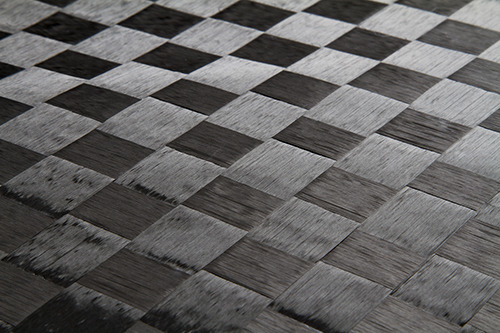
‘TeXtreme’ is currently the main fiber material for top blades of Stiga. Three kinds of TeXtremes are being used for ‘Carbonado’ series, and ‘TeXtreme+’ is being used for ‘Dynasty Carbon’. ‘TeXtreme’ is a kind of woven carbon fiber. But, it is different from conventional woven carbon fiber. The spread tow structure makes the fiber of TeXtrme straighter. The surface of TeXtreme is very flat, and it is much thinner than conventional carbon fiber. It reduces the use of epoxy, and the result is enhanced energy efficiency and softer feeling. Because TeXtreme is softer than conventional carbon fibers, Stiga doesn’t need ALC or ZLC for realizing softer feeling.
’12K Energy Carbon’ is also based on ‘TeXtreme’. ’12K’ means that 12,000 fibers are included in one bundle of fiber. The one bundle of ’12K Energy Carbon’ looks somewhat wider than those of ‘TeXtreme’ or ‘TeXtreme+’.

The nameplate is made by Aluminum like other Stiga blades. But, differently from the nameplate of the other blades, the nameplate of ‘Legacy Carbon’ is colored only in black. But, to make the name of blade legible, two kinds of treatments are applied to black surface. The edge of nameplate and the background of ‘STIGA’ logo are gloss-finished. But, the background of blade name is matt-finished. It adds high-class feeling to the appearance of Legacy Carbon that can be somewhat too simple.

Like other Stiga blades, another Aluminum plate that expresses ‘HANDMADE IN SWEDEN’ is applied at the end of handle.
Then let’s observe the mechanical characteristics of ‘Legacy Carbon’ by Performance Indices.
2. Blades to be compared
The blades to be compared are as follows :
- Stiga Dynasty Carbon : TeXtreme+ / normal direction + Koto top layer
- Stiga Carbonado 45 : Low density TeXtreme / leaned direction + Limba top layer
- Stiga Carbonado 90 : Low density TeXtreme / normal direction + Limba top layer
- Stiga Carbonado 145 : Middle density TeXtreme / leaned direction + Limba top layer
- Stiga Carbonado 190 : Middle density TeXtreme / normal direction + Limba top layer
- Butterfly Timo Boll ALC : ALC (Arylate fiber + Carbon fiber) + Koto top layer
- Butterfly Timo Boll ZLF : ZLF (PBO fiber only) + Koto top layer
- Butterfly Korbel : Representative of 5-ply wood offensive blade
- Stiga Allround Classic : Reference (all values are 1.0)
The most important one to be compared with ‘Legacy Carbon’ is ‘Dynasty Carbon’ that is another top model of Stiga blade range. And, also 2 low density ones (45 and 90) and 2 middle density ones (145 and 190) among 6 versions of ‘Carbonado’ series can be compared with ‘Legacy Carbon’. High density versions (‘Carbonado 245’ and ‘Carbonado 290’) are excluded because those two are too fast for this comparison.
Two versions (ALC and ZLF) of ‘Timo Boll’ series can also be compared with ‘Legacy Carbon’, although the top layer of those two aren’t Limba but Koto.
‘Korbel’ is the representative of 5-ply wood offensive blade. ‘Allround Classic’ is the reference blade of Performance Indices system. (All values for ‘Allround Classic’ are 1.0.) Those two are not direct competitor of ‘Legacy Carbon’, but will be compared just for reference.
Comparison will be done by performance indices. Concerning the detail of four performance indices, please refer to following articles in ‘Background’ section :
- Performance indices : the way to evaluate blade by measurement
- The example of comparison by performance indices
3. Comparison by Performance Indices

Fig.09 shows the comparison graph of Elasticity Indices.
The Ep of ‘Legacy Carbon’ is 1.63. It is lower than the Ep’s of all Stiga blades in this comparison. And, the Ec of ‘Legacy Carbon’ is 1.32 which is also the lowest value among the Ec’s of Stiga blades in this comparison. That result tells us that high elasticity isn’t what ‘Legacy Carbon’ amis at. Maybe that is because ‘Legacy Carbon’ (= about 5.7mm) is thinner than the other Stiga blades in this comparison (= about 6.0mm). It is expected that ‘Legacy Carbon’ is the blade for the playing style whose main strategy is continuous topspin that lays importance on safety and control. Please note that it doesn’t mean that ‘Legacy Carbon’ can’t make powerful topspin. Skilled players will be able to make very powerful topspin from ‘Legacy Carbon’. However, for the players of low level, ‘Legacy Carbon’ will be the blade not for power but for control of course, because ‘Legacy Carbon’ will require more power and skill of player for making powerful topspin.
With Ep=1.89 and Ec=1.51, ‘Dynasty Carbon’ is more elastic than ‘Legacy Carbon’. We can estimate that ‘Dynasty Carbon’ is more focused on power, when compared with ‘Legacy Carbon’. Among ‘Carbonado’ series, the one which is the closest to ‘Legacy Carbon’ is ‘Carbonado 45’. With Ep = 1.80, it is faster than ‘Legacy Carbon’. But, probably some players will feel that ‘Carbonado 45’ is just a bit faster than ‘Legacy Carbon’. ‘Carbonado 190’ and ‘Timo Boll ALC’ are much faster (Ep = 2.10 and 2.14 respectively) than ‘Legacy Carbon’. Apparently those two are more concentrated on power.
It is interesting that the Ep of ‘Timo Boll ZLF’ (= 1.63) is same as that of ‘Legacy Carbon’. But, Ec of ‘Timo Boll ZLF’ (= 1.47) is much higher than that of ‘Legacy Carbon’ (= 1.32) and is close to that of ‘Dynasty Carbon’ (= 1.47)’. It is expected that ‘Legacy Carbon’ and ‘Timo Boll ZLF’ are similar to each other in continuous topspin. However, when the technic that requires harder impact force is performed, players will feel that ‘Legacy Carbon’ is softer than ‘Timo Boll ZLF’.
The Ep and the Ec of ‘Korbel’ (= 1.54 and 1.27 respectively) are lower than those of ‘Legacy Carbon’. But, we can expect that ‘Legacy Carbon’ will be the good replacement of ‘Korbel’ because the shape of the graphs of ‘Legacy Carbon’ is similar to that of ‘Korbel’.
Examining Ec/Ep is an easier way to understand the tendency of elasticity of blades. Fig.10 shows the relationship between Ec/Ep and Ep.

Ec/Ep expresses the ‘tendency’ of the elasticity of blade. By examining Ec/Ep and Ep at the same time, we can easily understand the behavior of blades.
On the graph, all the blades except for reference blade are in ‘Hold’ range (Ec/Ep < 1.0). ‘Timo Boll ZLF’ is in ‘Mild Hold’ range or the border between ‘Mild Hold’ range and ‘Deep Hold’ range. And, ‘Allround Classic’ which is the reference blade is on neutral line (Ec/Ep = 1.0) that expresses that the behavior of the blade is linear. All the other blades except for those three are in ‘Deep Hold’ (Ec/Ep < 0.9) range.
As we expected from the comparison by bar graph of Ep and Ec, ‘Legacy Carbon’ is positioned very close to ‘Korbel’ on the graph. Therefore, again we can expect that ‘Legacy Carbon’ will be good replacement of ‘Korbel’ for the enhancement of power. Thanks to better energy efficiency by using fiber material, players will make more power from ‘Legacy Carbon’ than from ‘Korbel’ without much adjustment of the way of using blade. On the contrary, we can notice that ‘Timo Boll ZLF’ isn’t close to ‘Legacy Carbon’ although the Ep’s of those two are same as each other. Players will feel much difference between ‘Timo Boll ZLF’ and ‘Legacy Carbon’.
It is interesting that the ‘hold’ level of ‘Dynasty Carbon’ is not much different from that of ‘Legacy Carbon’. It means that the difference between ‘Dynasty Carbon’ and ‘Legacy Carbon’ is only in the primary elasticity. If a player feel that ‘Dynasty Carbon’ is too fast but it holds ball not insufficiently and not excessively when the player hits ball very hard, ‘Legacy Carbon’ which is slower but provides the same level of hold is expected to be the best replacement from ‘Dynasty Carbon’. And, vice versa. Additionally, if the player requires more elasticity but wants that the level of holds is not different from that of ‘Dynasty Carbon’, ‘Timo Boll ALC’ or ‘Carbonado 190’ will be good choice.
During last decades, many players have replaced their ‘Korbel’ with ‘Timo Boll ALC’. Probably that have been possible because the ‘hold level’ of ‘Timo Boll ALC’ is not much different from ‘Korbel’. However, the problem is that the primary elasticity of ‘Timo Boll ALC’ is too much higher than that of ‘Korbel’. Some players could have adapted themselves to new much faster blade. But, probably there have been the other players who could not adapt. For those players, ‘Legacy Carbon’ and. Dynasty Carbon’ will be able to good solution. If ‘Timo Boll ALC’ is the speed-up of LEVEL 3, ‘Dynasty Carbon’ will be the speed up of LEVEL 2, and ‘Legacy Carbon’ will be the speed-up of LEVEL 1. Both of ‘Legacy Carbon’ and ‘Dynasty Carbon’ are placed at good positions between ‘Korbel’ and ‘Timo Boll ALC’.
Then successively, let’s compare Vibration Indices. Fig. 11 shows the comparison graph of Vibration Indices.
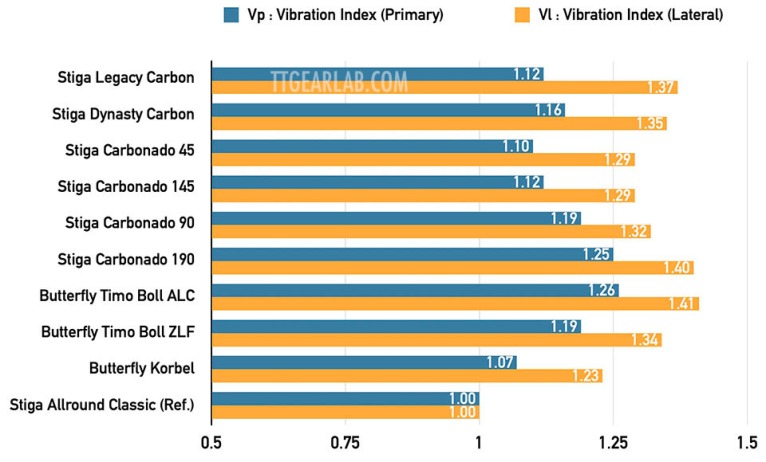
Fig.11 Comparison by Vibration Indices
Vibration Indices are concerned with feeling. Vp indicates primary feeling which is transferred to player’s palm. And, Vl is the feeling at the wing of a blade. It is felt by player’s index finger or middle finger.
The Vp of ‘Legacy Carbon’ is 1.12. It is lower than those of ‘Dynasty Carbon’ (= 1.16), ‘Carbonado 90’ (= 1.19) and ‘Carbonado 190’ (= 1.25). However, it is same as that of ‘Carbonado 145’, and interestingly it is higher than the Vp of ‘Carbonado 45’ (= 1.10). When we just observe primary feeling, ‘Legacy Carbon’ gives similar hardness as ‘Carbonado 145’, and it is harder than ‘Carbonado 45’. That is different result from what we observed in the comparison of Elasticity Indices. And, we can think that ‘Legacy Carbon’ is a bit softer than ‘Dynasty Carbon’, ‘Carbonado 90’ and ‘Timo Boll ZLF’ (Vp = 1.19), and is noticeably softer than ‘Carbonado 190’ and ‘Timo Boll ALC’ (Vp = 1.26). Finally, ‘Legacy Carbon’ is a bit harder than ‘Korbel’ whose Vp is 1.07.
The Vl of ‘Legacy Carbon’ is 1.37. It is higher than the Vl’s of Stiga blades in this comparison except for ‘Carbonado 190’. The Vl of ‘Dynasty Carbon’ is 1.35. It is a little bit lower than that of ‘Legacy Carbon’. We can consider that it is very close to the value of ‘Legacy Carbon’. The Vl of ‘Carbonado 45’ and ‘Carbonado 145’ is 1.29. That is noticeably lower value than that of ‘Legacy Carbon’. The blades those show higher Vl’s than ‘Legacy Carbon’ are ‘Carbonado 190’ (= 1.40) and ‘Timo Boll ALC’ (= 1.41). But, the difference isn’t big. ‘Timo Boll ZLF’ (= 1.34) and ‘Korbel’ (= 1.23) also show lower values than ‘Legacy Carbon’.
It is difficult to explain something from this graph. Examining Vl/Vp will be the better way of comparison. Fig.12 shows the relationship between Vl/Vp and Vp.
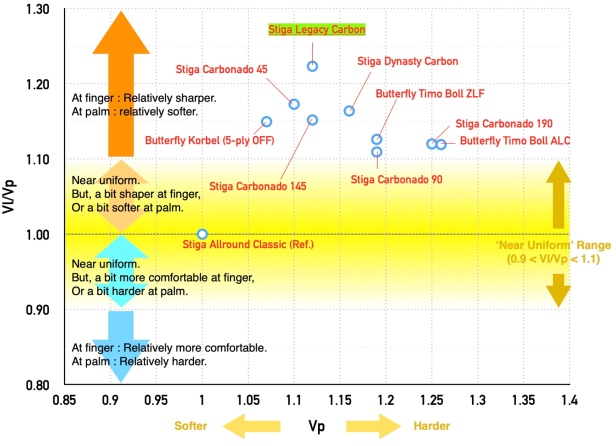
Fig.12 Vl/Vp vs. Vp
On the graph, all the blades except for the reference blade (= ‘Allround Classic’) are placed in upper (Vl/Vp > 0) area – ‘relatively sharper at index finger’ range. Also, none except for reference blade is placed in ‘near uniform’ (0.9 < V/Vp < 1.1) range.
‘Legacy Carbon’ is placed at the top of all models. It means that its relative feeling at index finger is sharper than any other blades in this comparison. But, it may be somewhat difficult for some players to distinguish the difference of relative sharpness between ‘Legacy Carbon’ and ‘Dynasty Carbon’ or ‘Carbonado 45’, because the other blades than ‘Legacy Carbon’ are also placed at very high range on the graph. It can be summarized that the other blades in this comparison gives very sharp relative feeling but ‘Legacy Carbon’ gives even sharper feeling. Although ‘Legacy Carbon’ gives the sharpest relative feeling, in this comparison we’d better compare blades just by primary feeling while just keeping the placement of ‘Legacy Carbon’ in mind. The difference of Vl/Vp between ‘Legacy Carbon’ and another blade such as ‘Carbonado 45’ may be important for some players if those players are very sensitive to this kind of feeling. But, it may be meaningless for other players who aren’t that sensitive.
The primary feeling of ‘Legacy Carbon’ is quite soft. ‘Legacy Carbon’ is noticeably softer than ‘Timo Boll ALC’ and ‘Carbonado 190’ those are the hardest in this comparison. And, ‘Timo Boll ZLF’ and ‘Carbonado 90’ are placed between ‘Legacy Carbon’ and the two hardest blades. Again, ‘Dynasty Carbon’ is placed between ‘Legacy Carbon’ and the group of ‘Timo Boll ZLF’ / ‘Carbonado 90’.
If a player wants to replace blade with faster/harder one but doesn’t want to change the level of Vl/Vp, ‘Legacy Carbon’ will not be best choice. In that case, ‘Dynasty Carbon’ will be the optimum choice. And, harder ones such as ‘Carbonado 190’ are also considerable. But, if the player doesn’t want the big increase of hardness, and sharper relative feeling at index finger is acceptable, ‘Legacy Carbon’ will be a seriously considerable blade.
And, if a player is currently using ‘Carbonado 145’ but feels that the feeling transferred to index finger is not sufficiently exciting, ‘Legacy Carbon’ will be the good solution.
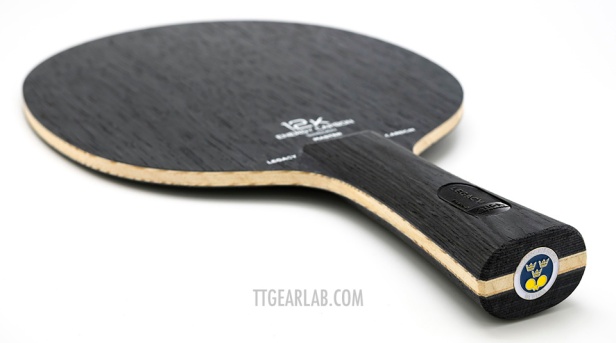
4. Summary
The result of comparison can be summarized as follows :
- The primary elasticity index of ‘Legacy Carbon’ is lower than those of ‘Dynasty Carbon’ and ‘Carbonado’ series. It means that ‘Legacy Carbon’ is more control-oriented blade than ‘Dynasty Carbon’ and ‘Carbonado’ series. ‘Legacy Carbon’ provides similar primary elasticity as ‘Timo Boll ZLF’ which is a very good blade for continuous topspin. However, the central elasticity index of ‘Legacy Carbon’ is much lower than that of ‘Timo Boll ZLF’.
- The primary vibration index of ‘Legacy Carbon’ is lower than those of fiber blades in this comparison except for ‘Carbonado 45’ and ‘Carbonado 145’. ‘Legacy Carbon’ is as soft as ‘Carbonado 45’ in primary feeling. However, the lateral vibration index of ‘Legacy Carbon’ is very high. And, it makes the relative value of feeling of ‘Legacy Carbon’ the highest in this comparison. The edge feeling of ‘Legacy Carbon’ is as hard as that of faster ‘Dynasty Carbon’ or much faster ‘Carbonado 190’ or ‘Timo Boll ALC’.
- ‘Legacy Carbon’ is placed between ‘Korbel’ and ‘Dynasty Carbon’ on the Elasticity graph. It provides similar ‘Deep Hold’ characteristics as ‘Korbel’. It is faster than ‘Korbel’ but isn’t extremely faster. Therefore, it will be good replacement of ‘Korbel’ if a player want to increase the power of topspin without significant change of playing characteristics.
- ‘Legacy Carbon’ can also be very good solution when a player thinks that the primary elasticity of ‘Timo Boll ZLF’ is ideal but hopes that the blade holds ball deeper at strong impact. It can also be good solution when a player likes the primary feeling of ‘Carbonado 145’ but want more exciting feeling to index finger.
‘Legacy Carbon’ is soft blade with very sharp and exciting feeling. Its playing character is similar to that of ‘Dynasty Carbon’ but it provides less elasticity than ‘Dynasty Carbon’. However, thanks to high energy efficiency of fiber, skilled players will be able to make much more powerful topspin from ‘Legacy Carbon’ than from 5-ply wood offensive blades such as ‘Korbel’. The proper playing style with ‘Legacy Carbon’ is continuous topspin. ‘Legacy Carbon’ will be also good for aggressive quick topspin because a bit reduced elasticity and deep hold are ideal characters for aggressive style. But, it isn’t recommended for smash. Basically ‘Legacy Carbon’ is recommended for skilled players whose main technic is topspin, because it will be difficult for beginners to make powerful ball from ‘Legacy Carbon’. However, it can be also recommended for beginners because ‘Legacy Carbon’ is expected to provide very high ability of control.
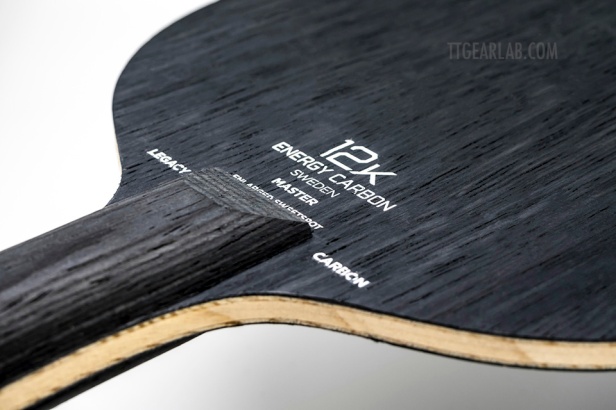
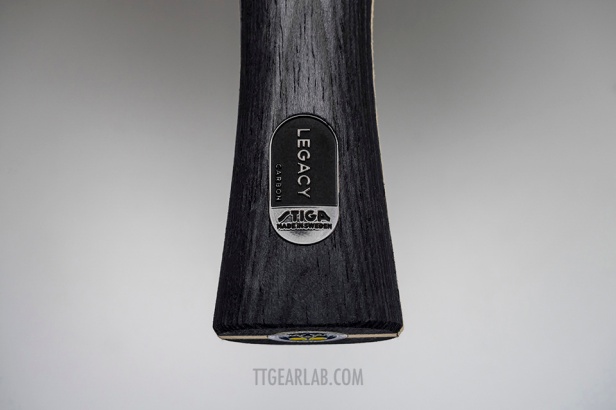

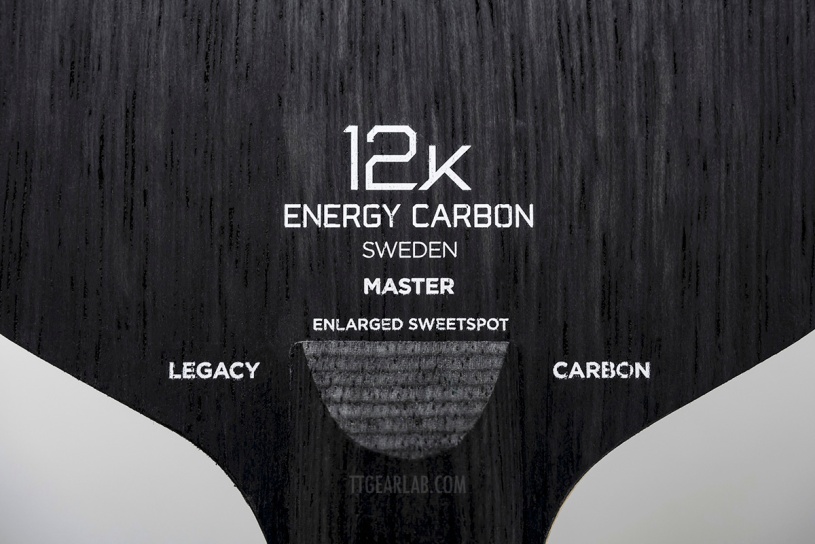
Very nice post (again) and enjoyed reading it.
looking forward to your posts each time.
Still learning to interpreter Ep and Ec correctly. Based on the show results, my initial thoughts were that Legacy Carbon is slower then Carbonado 45. However according to Stiga’s own data, that’s surely not the case.
Regardless, price tag of this blade is 200+ EUR and way over my budget.
Thanks again for a great post!
LikeLike
Thank you for comment.
In general, table tennis makers show the result based on the subjective data. And, sometimes that is different from objective data gathered by measurement. Especially there are many cases in table tennis because skilled players can make more powerful ball from the blade with lower elasticity. That is also the reason why players should select ‘optimum’ equipments those fits for their own conditions.
Without doubt, the elasticity of ‘Energy Carbon’ is lower than that of ‘Carbonado 45’. However, if it is used properly, it will make more powerful ball than ‘Carbonado 45’in ‘that’ condition.
That is also the reason why some blades with very low elasticity are announce as ‘offensive’ blades. The high speed of those blades are not by the elasticity but by players’ strong impact. And, those blades are suitable for those players to make full use of their ability. But, if different players use those blades, the result will be different.
LikeLike
Thanks for another great review! Keep meaning to ask – what set up do you play?
I read in other comments that you’re a fan of TB ZLF. That’s one of my favorite blades too, but I could never get used to the handle (too short). Do you have any suggestions for a similar feeling blades from other manufacturers?
Thanks in advance.
LikeLike
TB ZLF is a great blade. It gives the perfect harmony between power and control.
BTW, if your handle isn’t Chinese Penholder, the length of handle is 100mm. That is the regular length of most of shakehand blades, although there are some TT makers who apply a bit longer handle. But, the ‘longer’ means just 102, 103 or 105mm. Also, there are many cases that the blade with longer handle has bigger wing. Then actual feeling by player isn’t that much different.
I recommend Stiga Legacy Carbon if you want the blade close to TB ZLF. However, I’m not sure whether it will be the best recommendation. There isn’t the blade which can provide similar feeling with TB ZLF. That is because its actual feeling is very unique.
I suggest different solution. The issue on the handle length is because of the size of wing (= the part of blade that is not covered by rubber) in many cases. Even though the length of handle itself is fixed, player feels the handle with bigger wing shorter. (And vice versa.) Therefore, your problem can be easily solved just by making the wing of TB ZLF a bit smaller. (You can make the wing smaller by filing. After filing, you’d better use sandpaper for finishing.) It is worth trying. One problem is that ZLF is very strong, and filing is not easy, although it isn’t impossible.
LikeLike
Thank you Sir. Both Donic and Tibhar make models with handles over 100, although you’re right that the wing design effects how long the handle feels. For example on the Harimoto ALC the 100mm handle feels a bit better than on TB. But I appreciate the suggestions. Might give the TB ZLF another try.
LikeLike
Hey,
nothing to do with this blade, but do you have data for the new Xiom ALX36.5? how does it compare to Viscaria like blades?
thanks in advance!
LikeLike
I’m sorry but I don’t have the sample of 36.5.
LikeLike
Hi, why are comments disabled on your newest review:
LikeLike